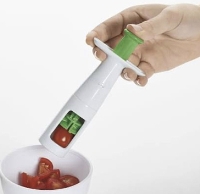Simple Safety: Choking
- Posted On:
- Written By: Deanna L. Lassegard, MD

Of all the things that I worry about as a mom, choking is definitely one of my top worries. As a physician, I know how dangerous choking is.
I am very choking conscious: my six year old is still not allowed small LEGO’s since he has a little sister. Every grape gets cut and all our Barbie’s don’t own any shoes. All of our electronics are taped shut so no batteries can come loose. My kids know that you sit down when you eat and I’m always in the kitchen with them when they eat. And still, with all of my safety steps, my 2-year-old daughter choked.
I was washing dishes and my 6 year old yelled at me, “Mom, Lottie is choking!”
And sure enough, she was purple and not moving any air. It was without a doubt the scariest minute of my doctor and mom life. Thankfully the Heimlich maneuver worked and my daughter is fine. But I have a renewed passion for how scary and serious choking can be.
According to Injury Facts 2017, choking is the fourth leading cause of unintentional injury death. Choking is also one of the leading causes of unintentional death for children under the age of 5 years old. At least one child dies from choking on food every five days in the United States, and roughly 12,000 children are taken to a hospital emergency room each year for food-choking injuries.
Choking occurs when a foreign object—like a piece of food—lodges in the throat or windpipe, blocking the flow of air.
Food accounts for more than 50% of choking episodes in children. The American Academy of Pediatrics recommends that parents keep hot dogs, nuts, chunks of meat or cheese, whole grapes and hard candy away from kids younger than 4 years old. Other food to keep away from young children includes popcorn; chunks of peanut butter; and chewing gum. I also worry quite a bit about gummies as I have personally seen several choking incidents with fruit gummies.

Other tips to remember:
- Cut food for babies and young children into pieces no larger than one-half inch. Product tip: I love the OXO Top Grape Cutter. I buy one for almost every parent that I know who has young children. You can learn more about them on the OXO site.
- Encourage children to chew food well.
- Supervise meal times.
- Insist that children sit down while eating.
- Avoid eating in the car.
While food is a culprit of choking, parents should also be alert for small objects that can also cause problems, and be aware of older children’s actions. Some choking incidents are caused when an older child gives a toy or food to a younger child not knowing it can be dangerous for them. Small objects to watch out for include:
- Balloons
- Buttons
- Coins
- Hair bows, barrettes, beads or rubber bands
- Pen or marker caps
- Pet food
- Refrigerator magnets
- Small button-type batteries
- Small balls or marbles
- Toys with small parts, or toys that can fit in your child’s mouth—especially Barbie shoes and Legos.
Heimlich maneuver for children
Because choking blocks the flow of air, it cuts off oxygen to the brain. This means first aid must be given as quickly as possible. To clear the airway of a choking infant younger than age 1, follow this information,highlighted by Mayo Clinic:
- Assume a seated position and hold the infant face down on your forearm, which should be resting on your thigh. Support the infant's head and neck with your hand, and place the head lower than the trunk.
- Thump the infant gently but firmly five times on the middle of the back using the heel of your hand. The combination of gravity and the back blows should release the blocking object. Keep your fingers pointed up to avoid hitting the infant in the back of the head.
- Turn the infant face up on your forearm, resting on your thigh with the head lower than the trunk if the infant still isn't breathing. Using two fingers placed at the center of the infant's breastbone, give five quick chest compressions. Press down about 1 1/2 inches, and let the chest rise again in between each compression.
- Repeat the back blows and chest thrusts if breathing doesn't resume. Call 911 if you cannot get the object dislodged.
- Begin infant CPR if one of these techniques opens the airway but the infant doesn't resume breathing.
- If the child is older than 1 year old, and conscious, give abdominal thrusts only. Be careful not to use too much force to avoid damaging ribs or internal organs.
My recommendation is for parents to prepare themselves for choking situations by learning the Heimlich maneuver and CPR in a certified first-aid training course.
Deanna L. Lassegard, MD, is an Emergency Physician at Campbell County Memorial Hospital in Gillette, Wyoming. Our resident safety expert, Dr. Lassegard writes Simple Safety blogs for Campbell County Health. Check them out at www.cchwyo.org/simplesafety.
